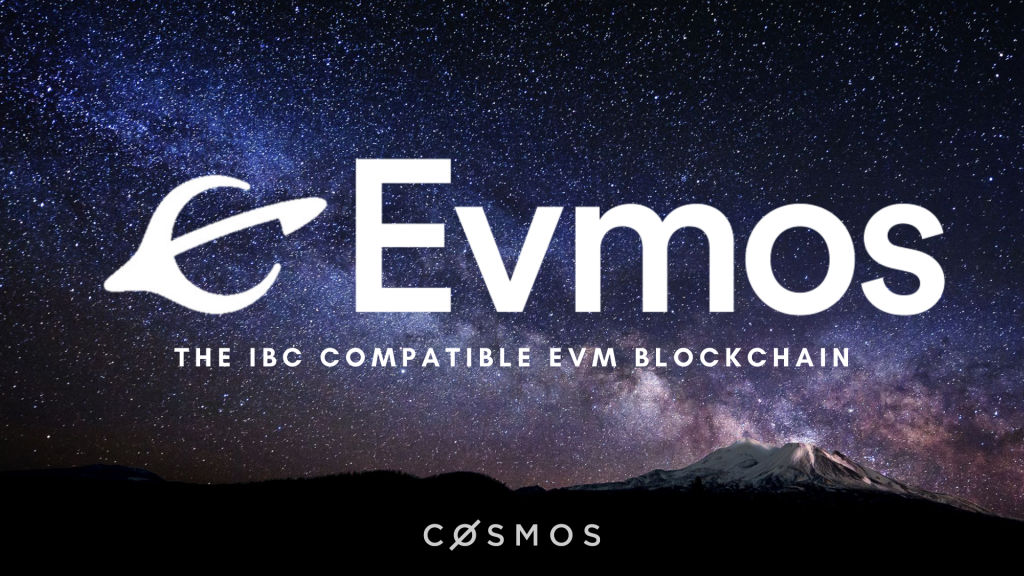
Evmos is a highly scalable, high-throughput blockchain running on a proof-of-stake (PoS) consensus mechanism and built with the Cosmos software development kit (SDK) on top of the Tendermint Core Byzantine Fault Tolerance consensus methodology.
The Tendermint Core BFT is essentially a plug-and-play consensus mechanism allowing developers to separate the network and application layer blockchains. For example, Evmos has EVM compatibility and is an “Ethereum copy,” but runs on the Cosmos SDK and can use PoS in contrast to Ethereum’s energy-intensive proof-of-work (PoW).
That allows Tendermint to combine the best of both worlds:
- EVM compatibility means DApps can build on both Evmos and Ethereum.
- Tendermint Core allows higher throughput = better performance than on Ethereum.
- Thanks to Cosmos’ inter-blockchain communication (IBC) Evmos is horizontally scalable and can communicate with other Cosmos blockchains like Binance Chain, Terra and Crypto.org.
Thus Evmos is a step towards the philosophy of modular blockchains that can scale horizontally (across chains) and vertically (layer-two on top of layer-one on top of layer-zero). This contrasts Ethereum, which is currently mostly focusing on vertical scalability.
How Does Evmos Work?
The key to understanding Evmos is understanding the Cosmos SDK, the Tendermint Core & Application Blockchain Interface (ABCI), and the Ethereum Virtual Machine.
Cosmos SDK
In simple terms, the Cosmos SDK is infrastructure by the Cosmos blockchain to build other PoS or proof-of-authority blockchains. The Cosmos SDK employs a modular framework over a virtual machine-based framework. Understanding the difference between those two allows us to understand why this SDK is so well-suited to building interoperable, application-specific blockchains.
Virtual machine blockchains (Ethereum) use smart contracts to build applications. These can be adequate for certain use cases – like rigid command-execution-type of apps — but make it difficult to construct complex platforms. The limited logic of smart contracts restrains the versatility and performance of applications — think building the Taj Mahal with rectangular bricks only.
The Cosmos SDK allows developers to use pre-built and custom-built models and test them before launch. Furthermore, connecting horizontally with other Cosmos-based blockchains exposes DApps to a bigger user base right from the start. This horizontal integration is the inter-blockchain communication (IBC) of Cosmos, in simple terms, an internet of blockchains.
Application Blockchain Interface (ABCI)
The ABCI is the interface between Tendermint (the state machine platform providing Evmos with its PoS consensus mechanism) and the application running (e.g., a money market DApp). It connects the Cosmos-based consensus mechanism and DApps by calling Request and receiving Response messages from the applications. These applications get relayed to the 150 validator nodes on Cosmos and allow applications to be processed in any programming language while using PoS.
To put it simply, ABCI is the infrastructure that allows Evmos to replace Ethereum’s proof-of-work with Cosmos’ proof-of-stake.
Ethereum Virtual Machine (EVM)
The EVM is Ethereum’s computation engine that runs like a decentralized computer consisting of millions of single computers. It runs the execution and deployment of smart contracts on Ethereum. Each node on Ethereum runs on the EVM, which is why Ethereum is sometimes described as the “decentralized super computer:” by building an application for EVM, you enable it to run on all Ethereum nodes.
Unique Features of Evmos
Evmos combines the three previously mentioned features to deliver a Layer-1 blockchain that is EVM-compatible but runs on the Cosmos SDK and uses the ABCI to employ PoS. This gives Evmos several key advantages:
Throughput and Performance
Evmos is not limited by Ethereum’s transaction speed but has the option to use Solidity to attract developers from Ethereum to build on it. This results in higher transaction speed on Evmos (thanks to Tendermint BFT) and better scalability (DApps can deploy on other EVM-compatible chains). Evmos thus becomes a “vanilla Ethereum” on Cosmos.
Interoperability Via IBC
The IBC “web of blockchains” opens Evmos up to quick deployment on all IBC blockchains that share the application’s smart contract language. In essence, the barrier to entry on other blockchains is lowered since Cosmos uses the aforementioned modular architecture instead of virtual machine-based architecture. Evmos thus immediately expands its potential user base.
Evmos Tokenomics
Evmos plans to deploy its token through a so-called “Rektdrop” aimed at rewarding active participants in the Cosmos ecosystem. It plans to airdrop rewards participants in the Ethereum and Cosmos ecosystems that got “rekt” at some point. For this reason, the token will be distributed to a large degree based on participation in the most popular Ethereum DApps like Aave, Olympus, and others.
Evmos took a snapshot for its Rektdrop on November 25, 2021, and although the team has not yet decided on the weighting for the different categories in the eligibility requirements, they did stress that more eligible actions qualified users for more tokens. Eligible actions include spending gas on any Ethereum application, bridging on EVM bridges, using Osmosis and providing liquidity or staking there, or being a victim of a rug-pull in projects like Polywork, Pickle Finance, Iron Finance, Cream, Thorchain and others.
The token will serve as a governance token but also as gas similar to ETH on Ethereum. However, it will use be employed as a vehicle to determine future economic outcomes that align the three main actors (Developers, Users and Validators). In practice this means:
- Paying developers and network operators for their services via built-in shared fee revenue model (the dApp Store).
- Voting on protocol upgrades.
- Registering tokens on the ERC20 module for EVM-IBC integration with ERC20s.
- Allotting usage incentives for applications on Evmos.
- Enabling precompiles for useful, high priority functionality.



















